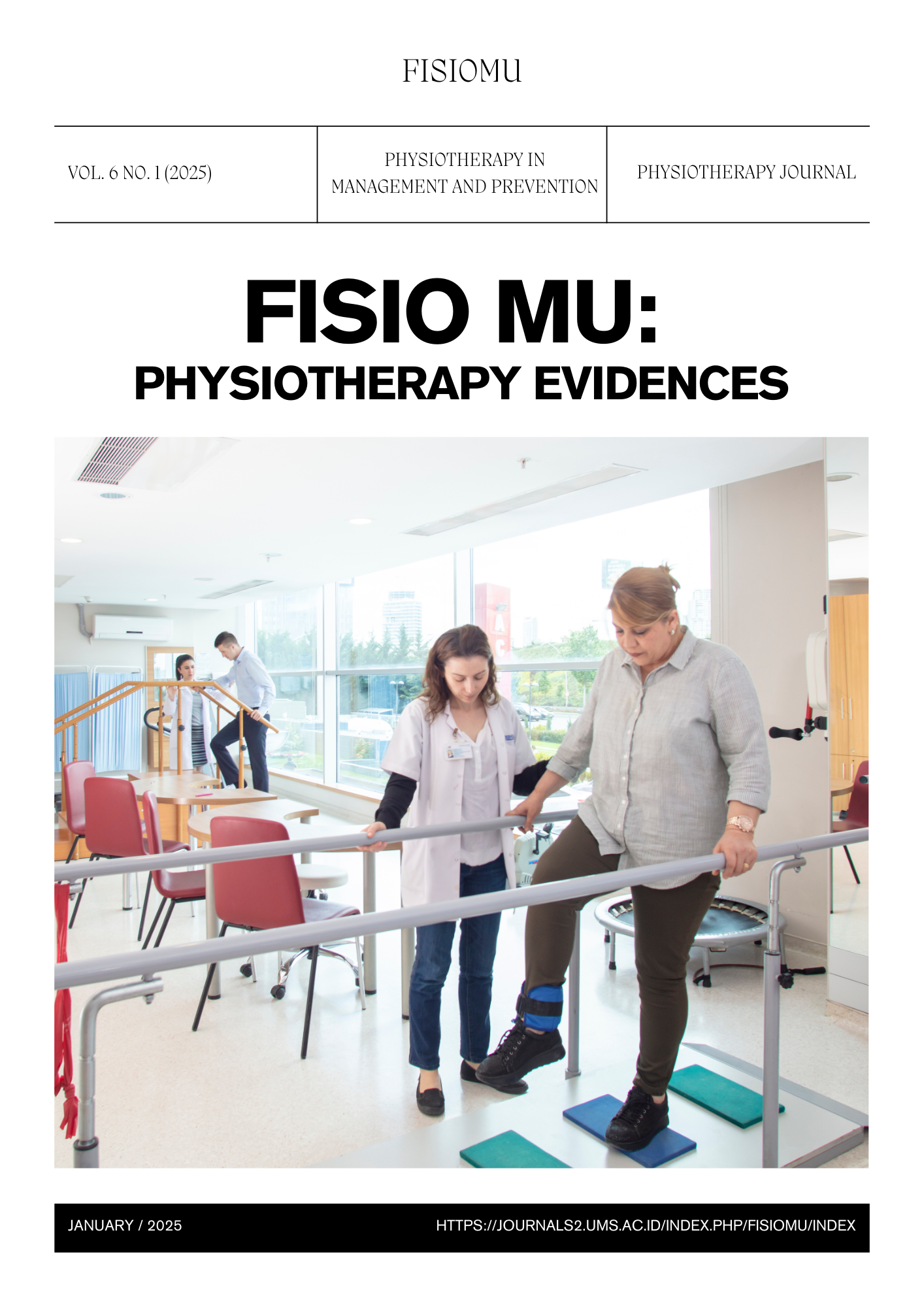Determinants of Flat Foot Incidence on Early Childhood Posture
DOI:
https://doi.org/10.23917/fisiomu.v6i1.7138Abstract
Scoliosis is a structural deformity of the spine in the lateral direction with a curvature of ≥10° in the coronal plane. The occurrence of posture disorders towards scoliosis is often only realised in adolescence, namely with an age range of 10-16 years. If you only realise it at this age, then it is too late, because other health problems can arise that affect your future life. Therefore, the existence of this study is expected to be able to make an instrument for the early detection of postural developmental disorders in preschool children against the incidence of scoliosis. From the examination that has been carried out on 94 students, it has been found that 74% of children have normal posture with a degree range of 10 to 40, and 25% of children have been detected with intermediate scoliosis (50 to 70). The next measurement that the researcher made was to measure the degree of arch of the child's foot. Measurements of normal categories of foot, flat foot and cavus foot use Clarke's angle. Clarke's angle is obtained from the meshing angle of the tangent formed by the first line connecting the medial edge of the first metatarsal caput and the heel and the second line connecting the first metatarsal caput with the crest of the medial longitudinal arch. Data was obtained that most children experience flat feet as much as 77%, which is dominated by male children.
Downloads
References
Awanis, A., Amarseto, B., & Diyono, D. (2022). Kompetensi Motorik Anak Usia Dini dengan Prestasi Belajar Di Taman Kanak-Kanak (Tk) Aisyiyah 5 Semanggi. FISIO MU: Physiotherapy Evidences, 3(2). https://doi.org/10.23917/fisiomu.v3i2.17604 DOI: https://doi.org/10.23917/fisiomu.v3i2.17604
Chou, M. C., Huang, J. Y., Hung, Y. M., Perng, W. T., Chang, R., & Wei, J. C. C. (2021). Flat foot and spinal degeneration: Evidence from nationwide population-based cohort study. Journal of the Formosan Medical Association, 120(10). https://doi.org/10.1016/j.jfma.2020.12.019 DOI: https://doi.org/10.1016/j.jfma.2020.12.019
Dewi, K. G. P., Dewi, A., Antari, N., & Indrayani, A. W. (2020). Perbedaan Gait Parameter Terhadap Tipe Arkus Pedis (Normal Foot, Flat Foot, dan Cavus Foot) pada Anak Sekolah Dasar Usia 10-12 Tahun di Denpasar Barat. Majalah Ilmiah Fisioterapi Indonesia, 8(2), 57–61. DOI: https://doi.org/10.24843/MIFI.2020.v08.i02.p11
Fadillah, V. N. M., Mayasari, W., & Chaidir, M. R. (2017). Gambaran faktor risiko flat foot pada anak umur 6-10 tahun di Kecamatan Sukajadi. Jurnal Sistem Kesehatan, 3(2), 97–102. DOI: https://doi.org/10.24198/jsk.v3i2.15010
Hegazy, F., Aboelnasr, E., Abuzaid, M., Kim, I. J., & Salem, Y. (2021). Comparing validity and diagnostic accuracy of clarke’s angle and foot posture index-6 to determine flexible flatfoot in adolescents: A cross-sectional investigation. Journal of Multidisciplinary Healthcare, 14. https://doi.org/10.2147/JMDH.S317439 DOI: https://doi.org/10.2147/JMDH.S317439
Maharani, A., Wibawa, A., & Adiputra, I. N. (2020). Perbedaan Kelincahan Antara Normal Foot Dan Flat foot Pada Anak Usia 10-12. Majalah Ilmiah Fisioterapi Indonesia, 8(3), 7. DOI: https://doi.org/10.24843/MIFI.2020.v08.i03.p05
Nisa, F., Aktifah, N., & Izzah, N. (2020). Perbedaan Efektivitas Strengthening Ball Roll Exercise dan Strengthening Heel Raises Exercise Terhadap Keseimbangan Statis Pada Anak Flat Foot Usia 9-10 Tahun di Kecamatan Wonokerto. Jurnal Penelitian Dan Pembangunan Kajen, 4(1), 73–84. DOI: https://doi.org/10.54687/jurnalkajenv04i01.6
Parera, A. C., Sengkey, L. S., & Gessal, J. (2016). Deteksi dini skoliosis menggunakan skoliometer pada siswa kelas VI SD di Kecamatan Mapanget Manado. E-CliniC, 4(1). https://doi.org/10.35790/ecl.4.1.2016.10831 DOI: https://doi.org/10.35790/ecl.4.1.2016.10831
Pfeiffer, M., Kotz, R., Ledl, T., Hauser, G., & Sluga, M. (2006). Prevalence of flat foot in preschool-aged children. Pediatrics, 118(2). https://doi.org/10.1542/peds.2005-2126 DOI: https://doi.org/10.1542/peds.2005-2126
Pristianto, A., Darojati, H. P. I. I., Nurhandrita, Z. P., Lazuardy, A. A., & Rahayu, A. D. (2022). Deteksi Dini Terkait Flat Foot Di Kb-Tk Al-Quran Terpadu Bintangku Surakarta. Jurnal Pengabdian Masyarakat Multidisiplin, 6(1), 19–24. DOI: https://doi.org/10.36341/jpm.v6i1.2616
Ripdianawati, S. S., & Ramadhani, A. N. (2024). The effect of strengthening exercise on postural balance and functional ability in children with flatfoot. FISIO MU: Physiotherapy Evidences, 5(1), 52–57. DOI: https://doi.org/10.23917/fisiomu.v5i1.2558
Romanova, E., Kolokoltsev, M., Vorozheikin, A., Baatar, B., Khusman, O., Purevdorj, D., Garov, S., Starshova, N., & Kiseliv, Y. (2022). Comprehensive program for flat foot and posture disorders prevention by means of physical education in 6-year-old children. Journal of Physical Education and Sport, 22(11). https://doi.org/10.7752/jpes.2022.11337 DOI: https://doi.org/10.7752/jpes.2022.11337
Seki, S., Yahara, Y., Makino, H., Kobayashi, K., Nakano, M., Hirano, N., Watanabe, K., Takahashi, J., Kawaguchi, Y., & Kimura, T. (2019). Differential rod contouring on thoracolumbar/lumbar curvature in patients with adolescent idiopathic scoliosis: An analysis with intraoperative acquisition of three-dimensional imaging. Journal of Orthopaedic Science, 24(5), 780–786. DOI: https://doi.org/10.1016/j.jos.2019.01.001
Syabariyah, S., Anesti, R., & Alfin, R. (2022). Kemaknaan Lengkung Kurvatura dan Rib Hump pada Skrining Risiko Skoliosis. Buletin Ilmu Kebidanan Dan Keperawatan, 1(02). https://doi.org/10.56741/bikk.v1i02.125 DOI: https://doi.org/10.56741/bikk.v1i02.125
Downloads
Submitted
Accepted
Published
How to Cite
Issue
Section
License
Copyright (c) 2024 Fisio Mu : Physiotherapy Evidaces Journal

This work is licensed under a Creative Commons Attribution-NonCommercial-NoDerivatives 4.0 International License.

This work is licensed under a Creative Commons Attribution-NonCommercial 4.0 International License.
Authors who publish with FISIO MU: Phsiotherapy Evidences agree to the following terms:
- Author(s) retain copyright and grant the journal right of first publication with the work simultaneously licensed under a Creative Commons Attribution-NonCommercial 4.0 International License that allow others to share the work within an acknowledgement of the work’s authorship and initial publication of this journal.
- Author(s) are able to enter into separate, additional contractual arrangement for the non-exclusive distribution of the the journal’s published version of the work (e.g. acknowledgement of its initial publication in this journal).
- Author(s) are permitted and encouraged to post their work online (e.g. in institutional repositories or on their websites) prior to and during the submission process, as it can lead to productive exchanges, as well as earlier and greater citation of published works.












